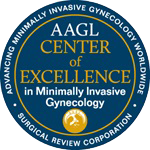Minimally Invasive Gynecologic Surgery
Minimally invasive surgery has become commonplace in operating rooms nationwide, and gynecologic surgery is no exception. Advances in technology have expanded the types of gynecological conditions that minimally invasive surgery treats.
Minimally invasive surgery typically means:
- Less time in the hospital
- Shorter recoveries
- Better overall outcomes
UMMC's Experts in Minimally Invasive Gynecologic Surgery
Since 2014, University of Maryland Medical Center has been designated as a Center of Excellence in Minimally Invasive Gynecology (COEMIG) by the AAGL and Surgical Review Corporation.
Procedures offered at COEMIG centers must adhere to strict guidelines. Doing so routinely leads to better outcomes and shorter recoveries. UMMC's experts review and analyze surgery data to continuously raise the quality of care and patient safety.
Up to 70% of all gynecologic surgeries at UMMC take a minimally invasive approach.
Our gynecology surgeons are designated as "Surgeons of Excellence in Minimally Invasive Gynecology." This means our physicians have served as the primary surgeon for at least 125 minimally invasive gynecological surgery procedures and adhere to the field's best practices and procedures.
Meet our COEMIG-designated surgeons.
To schedule an appointment with a surgeon at one of our locations, call 667-214-1300 or 866-608-4228.
What Is Minimally Invasive Surgery?
These procedures cause less damage to the body than traditional, or open, surgeries. As a result, recovery times are faster. Minimally invasive surgeries include:
- Laparoscopic surgery uses tubes, which are paired with cameras, and surgical tools inserted through small incisions.
- Hysteroscopy is similar to laparoscopy, but no incision is made. A tube is inserted through the vagina to examine the cervix or uterus.
- Robotic surgery enhances a surgeon's precision and capabilities as well as reduces a patient's recovery time and scarring. Our surgeons use the da Vinci robotic surgical system.
Procedures and Conditions
In the past, the only option for hysterectomy (removal of the uterus) was open abdominal surgery. Typically, patients would spend two to three days in the hospital with several months recovering at home. With laparoscopic hysterectomy, most women go home the same or the next day and are fully on their feet within a two weeks.
A wide range of gynecological conditions can be treated with minimally invasive surgery. And while these conditions can't always be treated with minimally invasive surgery, our highly trained surgeons will first consider whether you are a candidate for the less invasive procedure.
- Central pelvic pain and dysmenorrhea (laparoscopic presacral neurectomy)
- Ectopic pregnancy and inflammation of the fallopian tube (laparoscopic adnexal surgery)
- Ovarian cysts (laparoscopic adnexal surgery)
- Endometriosis
- Abnormal, excessive bleeding (endometrial ablation, a form of hysteroscopy)
- Fibroids (myomectomy)
- Cancers, such as ovarian, uterine or cervical
- Vaginal prolapse (Moschcowitz procedure)
Types of Minimally Invasive Surgeries
Laparoscopic Surgery
Laparoscopy, also known as keyhole surgery, is a surgical technique where a tube is inserted into small incisions then a small camera (less than a half inch in size) and surgical instruments are inserted through the tube. Surgeons can see potential issues, take tissue samples, make diagnoses and in some cases implement treatments.
There are a number of advantages to laparoscopic surgeries compared to open procedures:
- Smaller incisions, leading to shorter recovery time and less post-operative pain
- Fewer pain medications due to less post-operative pain
- Reduced blood loss, potentially lowering the chance of needing a blood transfusion
- Shorter hospital stays, and often with a same-day discharge
- Reduced exposure of internal organs, minimizing the risk of infection
Hysteroscopy
Hysteroscopy is a procedure where the inside of the cervix and uterus is visualized using a camera attached to a TV monitor. Doctors utilize this minimally invasive procedure to diagnose conditions and perform operations.
Diagnostic Hysteroscopy
Diagnostic hysteroscopy allows for the diagnosis of common conditions, such as:
- Fibroids
- Uterine polyps
- Uterine septum
- Uterine cancer
During the procedure, which is done under local anesthesia or general anesthesia, the camera (hysteroscope) is placed through the vagina and the cervix into the uterus.
Physicians note problems, if there are any, and may take a sample of the endometrial lining in cases of abnormal uterine bleeding.
Operative Hysteroscopy
Operative hysteroscopy is usually done under general anesthesia. This procedure is reserved for patients with conditions that have already been diagnosed, such as:
- Previously diagnosed fibroids
- Uterine polyps
- Uterine septum
- Blocked fallopian tubes
Certain types of fibroids, polyps or other conditions can be treated and removed hysteroscopy.
Endometrial ablation, a type of operative hysteroscopy, treats heavy or irregular bleeding in women who have finished their reproductive years. After uterine cancer as a cause of bleeding is ruled out — often during a diagnostic hysteroscopy — surgeons will perform an endometrial ablation.
Robotic Surgery
UMMC surgeons use the da Vinci robotic surgical system, the first FDA-approved device for gynecologic surgery. The robot enhances a surgeon's capabilities in the operating room. For example, it delivers three-dimensional views that are many times more powerful than the human eye and can reduce involuntary hand tremors.
Surgeons rely on robotic-assisted surgery in several minimally invasive procedures, including:
- Tubal ligation
- Ovarian cystectomy
- Myomectomy
- Radical hysterectomy with lymphadenectomy
Robotic-assisted surgery is performed in several sub-disciplines of gynecology:
- General gynecology
- Gynecologic cancer
- Reproductive surgery
- Pelvic and reconstructive surgery
To schedule an appointment with a surgeon at one of our locations, call 667-214-1300 or 866-608-4228.

